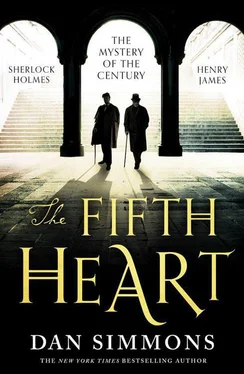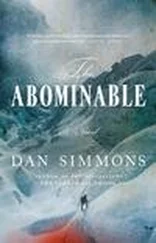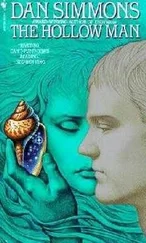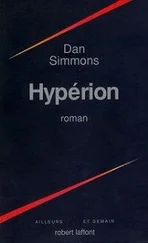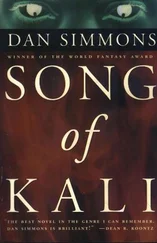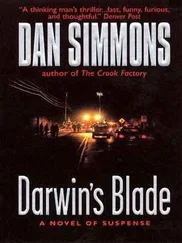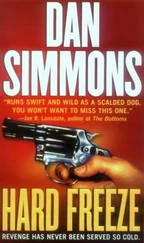“Who . . .” began John Hay.
“Who do you . . .” said Clarence King.
Holmes closed the door behind him and motioned with palms out for them to sit. “Everyone here but Mr. James—who has some hint of the truth—knew me the last few days as Jan Sigerson. My true name is Sherlock Holmes. I am a consulting detective. Until two years ago, I lived in London. I went to Nepal in eighteen ninety-one and have now come to Washington in service of Her Majesty’s Government and in the vital interest of the government of the United States of America.”
There was babble and outrage. Clarence King shouted until servants came knocking at the door inquiring as to whether everything was all right. Hay sent them away. Only James had remained seated. For a few moments he felt anaesthetized, totally immobilized, and during those moments he was convinced that either he had died in Paris, in the Seine, that Sunday night, or the deep melancholy that had driven him to France and the Seine two weeks earlier had driven him quite mad. Madness was the only logical explanation for what he was experiencing now.
But is it my madness or this Sigerson/Holmes’s?
Holmes waited until the outcry died down and at least John Hay sat back in his chair. Clarence King still stood and paced, his hands clenched into fists, his usually amiable expression now frozen into a frightening scowl.
“In the spring of eighteen ninety-one, Edward Hooper—you all knew him as ‘Ned’—hired me to look into the circumstances of his sister’s death in eighteen eighty-five and the fact that every year on the anniversary of her death, he—and each of you—has received one of these .” Holmes removed from his tweed jacket not one but six of the She-was-murdered typed cards and handed the short stack to John Hay, whose expression of surprise almost instantly changed to one of shock.
“Ned is dead,” snapped Clarence King. “A suicide like his sister seven years before him.”
“I know that Ned Hooper is dead,” said Holmes. “I do not yet know—none of us here know—if either his death or his sister Clover’s was so simple as suicide.”
“Everyone . . . everyone . . . agreed that Clover’s death was suicide,” snapped King, taking an aggressive step toward Holmes, who watched the shorter but stouter man with what seemed to be complete calm. Holmes removed his black clay pipe and with a “May I?” to Hay, who nodded distractedly, fussed with lighting it. At least, based on the scent when it was lit, the tobacco was not that cheapest of shags he’d used near James a few times on the ship and train.
“Clover took potassium cyanide when she was alone in her house,” continued King, who waved away the stack of cards when Hay tried to pass them to him. “Ned Hooper tried twice to kill himself—once by throwing himself in front of a trolley—and finally threw himself from a high window of the sanitorium . . . some called it an asylum . . . to which he’d been referred.”
“But no one we know of saw either Mrs. Adams’s death by potassium cyanide or her brother Ned’s actual throwing himself from the window,” said Holmes between slow puffs that seemed to be further antagonizing King.
“You don’t need to see the snow falling to know it’s snowed if you go to sleep outside in the mountains on dry grass and wake up under a coating of new snow,” growled King.
“Very good,” said Holmes. “I applaud the use of inductive logic. However, in this case, we have a brother and sister dead supposedly by their own hand, but in neither case need it be suicide. Mrs. Clover Adams became quite good friends with a Miss Rebecca Lorne in the year before she died. Is this not true?”
“What?” snapped King.
“She did,” said John Hay. “I met Miss Lorne on several occasions. A pleasant lady.”
“And this was the lady who was waiting outside Mr. Adams’s former home when he came home to find his wife dead upstairs, is this not correct?” said Holmes. He relit the pipe.
“So what?” said Hay, sounding angry himself now. “Miss Lorne visited Clover almost every day in those last months. She was waiting outside when Adams was about to go to his appointment that morning. Or perhaps when he came back for something, I forget which. At any rate, Miss Lorne did not find the body . . . poor Henry did.”
“And Miss Lorne moved away from Washington a month or so after Clover Adams’s death?” Holmes’s voice was soft but persistent.
“Yes . . . to Baltimore,” said Hay. “Where she married a Mr. Bell some months later . . . by the summer of eighteen eighty-six, I believe. Henry still corresponded with her in the years after Clover’s death. Perhaps he still does from time to time.”
“I doubt it very much,” said Holmes. “I believe the woman you knew as Miss Rebecca Lorne was murdered shortly after she left Washington. Perhaps before.”
“You’re mad,” said Clarence King.
“Wait a minute,” said Hay. “Let’s discuss this . . . performance of the past few days and last night in which you claimed to be an explorer named Jan Sigerson. What on earth was that about?”
“A necessary ruse,” said Holmes. There was a third leather chair empty, one facing Hay’s desk, and he sat in it. “Those who have been hunting me knew that I would come to honor Ned Hooper’s request.”
“Those who have been hunting you . . .” said Hay.
“Damned slow about getting here,” said King. “You say Hooper—you have no right to call him ‘Ned’, whoever you are—asked you to come help him with this cards-thing in the spring of ’ninety-one, yet here you are showing up in the spring of ’ninety-three, months after Ned killed himself. Good thing you’re not a fireman or policeman.”
“I am a policeman in a manner of speaking,” Holmes said quietly. He had sprawled into the deep chair with one leg thrown carelessly over the other.
Henry James finally found his voice. He deliberately spoke to Hay and King, not to the man sitting opposite him. “Last night we received, from Mr. Vollebæk and his family, near-conclusive proof that this man, in make-up or not, is the Norwegian explorer Jan Sigerson. We heard the Norwegian language spoken fluently between them. We heard His Excellency Mr. Vollebæk speak of Norwegian friends he and Sigerson had in common. We then saw the slides of Sigerson’s expedition into Tibet, including the photograph from Bombay of Sigerson with the younger explorer Sven Anders Hedin—known to all three of the Vollebæks. It seems to me that the only sane conclusion we can draw here is that this man has long been pretending to be the English detective Sherlock Holmes. Perhaps the high-altitude in the Himalayas affected his mind . . .”
Holmes removed the pipe from his mouth and chuckled. “My dear James, do you accept the legerdemain of a theatrical magician with as much eager credulity as you did my bona fides for being Jan Sigerson?”
James felt himself flushing with anger and embarrassment but he forced his voice to remain calm, reasonable, and civilized. “There was no reason for Mr. Vollebæk and his wife and daughter to perjure themselves with . . .”
“There was one excellent good reason, my dear James,” said Holmes, standing again and prodding the air with the stem of his pipe. “As soon as I learned that I’d be dining with the Vollebæks on Sunday, the twenty-sixth, I cabled King Oskar the Second of Scandinavia and asked him to have his Norwegian emissary support my story and disguise. You see, I still have use for explorer Sigerson. Mr. Vollebæk is giving interviews to reporters from the Washington Post and a writer from the Washington Critic even as we speak, telling all about his delightful evening with his fellow countryman Sigerson at the home of Mr. John Hay . . .”
Читать дальше
